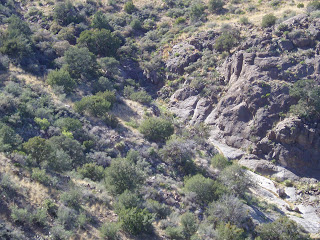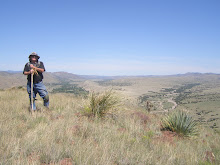Chiricahuas, Ed Sweeney & Fred Lafferty




Friday, September 25, several of us from Silver City, drove over to the Chiricahuas south of Rodeo, New Mexico, to meet with #1 writer of Apache history, Edwin Sweeney, to revisit a battle site fought over 140 years ago. The story, written years ago by Ed Sweeney, in his book, "Cochise: Chiricahua Apache Chief," was an incident in the skirmishing and campaigning against Cochise's Chiricahua Apaches.
**The photo at top left is the leading writer on Apacheria -- Edwin Sweeney. He holds the "map drawing" a soldier of Col. Reuben Bernard's command made after the fight at the "rimrock mesa" skirmish.
The photo at right is Navy Commander Fred Lafferty, (Ret), great-grandson of Lt. John Lafferty, First Cavalry, who distinguished himself with bravery in the skirmish with Cochise's Apaches near where Camp Rucker was ultimately located.
The photo at the left is of the rimrock mesa top (one of several "tops" that charging troopers would have encountered as they tried to make their way to the very flat top of the mesa where Cochise and his men were established.
The photo on the right is of the large hill mass to the north/northeast of the rimrock mesa where Cochise and his Apaches fought Col. Reuben Bernard's troopers of the First Cavalry.
The American commander of the troops chasing the Apaches was Col. Reuben Bernard, known in some circles as an aggressive "Indian fighter." Col. Bernard eventually was named a General at the conclusion of his military career. A summary of the active military career Col. Bernard experienced is contained in a book, "One Hundred and Three Fights and Scrimmages: The Story of General Reuben F. Bernard," by Don Russell (reprint now available on Amazon.com), new/used; Stackpole Books, Mechanicsburg, PA.
Edwin Sweeney wrote an Introduction to the reprinted volume in 2003, and summarizes the fire fights (skirmishes) we'd call in current combat lingo. The fire fight in October, 1869, saw Americans killed and wounded, and the same for the Apaches who fought from their mesa positions, fairly secure in rimrock based firing positions. And it was in that fire fight that the life of Lt. John Lafferty, cavalryman, was altered forever.
Lafferty was wounded, and suffered painful and debilitating effects from his wound for the rest of his life. He was also the great-granddfather of Fred Lafferty, local citizen and retired naval aviator careerist, who I met two years ago, as I interviewed him for an article about his great-grandfather, his father, and his own military career.
It was quite a trip to the Chiricahuas, south of Rodeo, south of Cave Creek. The Chiricahuas are truly beautiful this time of year, and the grasses that grew there were lush and so different from the land directly east of the highway from I-10 to Douglas, AZ. Betty Lafferty said that one driving south, towards Douglas, would never know the beauty of the Chiricahuas we saw along the road to Rucker Cañon. She was right. A very beautiful country indeed. It's no wonder that the Chiricahua Apaches loved the country and it's clear why they would have fought so hard to retain these mountains and lowlands against the Americans.
The trip, I believe, gave Fred and his wife, Betty, some satisfaction in that they've been married over 50 years, and undoubtedly, have shared the story many times over those years. That Fred is descended from John Lafferty (who was finally brevetted as a Captain before he retired for medical reasons), is interesting in that this was a particularly well documented fire fight, as far as fire fights go in military history. Col. Bernard, of course, was required to report on his "scouts" which began and ended at Ft. Bowie. In the era, each scout or what we'd call, now, "patrol," had a requirement for the scout leader to report how far his unit had "marched," and, what the conditions were that they encountered before stopping for the night. Regular features of such patrols included what the condition of the route of march was; encounters with Apaches; casualties; the nature of water, grass and timber availability at each evening bivouac.
In the case of the "rocky mesa" fire fight in which Lt. Lafferty was so badly wounded, an enlisted man actually drew, on four sheets of paper, a drawing of the terrain of the fight, and then marked, with numbers, the significant places or important features that defined the fight itself. Because of that drawing, historians, such as Edwin Sweeney and myself, have been able to literally SEE where Lt. John Lafferty was wounded.
With the detail we had available to us, then, Edwin Sweeney was highly pleased to be able to take Fred Lafferty almost to the exact spot where his great-grandfather was wounded by an Apache. Lt. Lafferty, in today's realm of awards granted for heroic actions, would have surely been nominated for at least, a Silver Star (SS). Perhaps even a Distinguished Service Cross (DSC) for heroism. The reason Lt. Lafferty was shot was because he'd exposed himseslf, and tried to recover the bodies of two dead soldiers, on that rocky slope. The concern, of course, was the fear that the bodies of the two dead men would be horribly mutilated, if they had to be left on the field of battle.
Because Lt. Lafferty was so badly wounded (a heavy duty rifle round shattered his right jaw), the bodies were actually left on the scene overnight. Thus far, I've not found any specific mention of whether those bodies were mutilated during the night. Contrary to the nature of Plains Indians, the Apache were very frightened of being around, much less, touching dead bodies. To touch a dead body was a very dangerous thing for Apaches to do. The Apache were very superstitious of death. They would normally not enter a wickiup if a person had died in that wickiup, and had been dead for a period of time.
The Apache believed that "ghosts" of the dead roamed the earth, seeking solace, or, perhaps, if malevolent, lure the living into the world of the dead. If a person had died in a wickiup, and could not be touched, then the entire wickiup and body would be burned together. The name would not be spoken again. This is one reason why some names were forgotten of ancestors, by living Apaches. Perhaps in the days before Spanish, Mexicans and Americans began to encounter the Apaches, names of dead relatives really were forgotten, so that tracking lineage was difficult.
I'm forever grateful an enlisted man was so gifted in his ability to draw the battle scene, we were able to go to the spot where Lt. John Lafferty was so badly wounded, in October, 1869. For me, as someone who was badly wounded in combat, I've always felt that wherever, in the world, a soldier dies, or is wounded ... that that spot (particularly where people have been killed in combat), is sacred.
Wherever it may be, wherever a person dies defending his or her way of life, that spot is sacred for me. Whether Nazi, Apache, Communist Viet Cong, or American GI invader, the sacrifice for the "cause" is most often made for at least a perceived worthiness of that cause. There may be some who are seriously deluded about the rightness of their causes, but people who sacrifice their lives do so with generally, good intentions.
Americans, in the end, had the luxury of returning to the site of the fight, the next day, to retrieve bodies left on the field. One has to wonder, though, how many Apaches were really killed in this fight? What did troopers do to their bodies? Were their bodies left to rot on that mesa? What did the Apaches do if they left the battle field, and returned to find decomposing brother Apaches among the rocks and cactic?
So far as the Apaches are concerned, we don't know their names, nor what kind of warriors they had been, before finding death there, in October 1869. Forever, the relatives of those dead Apaches would see their fate, as honored men, in doubt, if they had not been able to be cared for properly, as Apache custom dicates. So, we Americans were lucky to be able to return to the sight of a fire fight that occurred 140 years ago, and show the descendant of John Lafferty, where his ancestor was badly wounded, fighting Apaches who were often like ghosts.
That's a clear connection between the war I fought in Vietnam, and the war Lafferty, et al, fought with the Apaches, in the Chiricahua Mountains. The elusiveness of the "enemy," so far as the Apaches, and Viet Cong were concerned, was bothersome. Why won't the bastards stand and fight? What a bunch of cowards! What's the matter with them! We never find any bodies. Or, they disappear like ghosts.
And so they did ... Apaches and Viet Cong. Did we not do the same thing in our Revolution?
Of course, we did. And were proud of it, and turned the tide against the finest professional military in the world, at the time. Upstart colonials beat the best the British Crown could send our way. And so, I suspect, many a soldier in the U.S. Cavalry, during the Indian wars, could recall how a great-great-grandfather had told them about fighting the British, and how they had tweaked the Brits with their ambush and run style of warfare. It drove the British nuts, and it drove American soldiers nuts, when it was the Apaches turning the screw on us.
So, too, now, in Afghanistan and Iraq.
The wheel of time and war always turn. Sooner or later, those on top will find themselves on the bottom. It's simply inevitable. By now, we should understand that all Empires have cycles, and that modern America, fighting in Iraq and Afghanistan, needs to remember what it was like to fight hard for your own land. Say what you might about the Apaches: who could ever blame them for fighting for these lands?

























